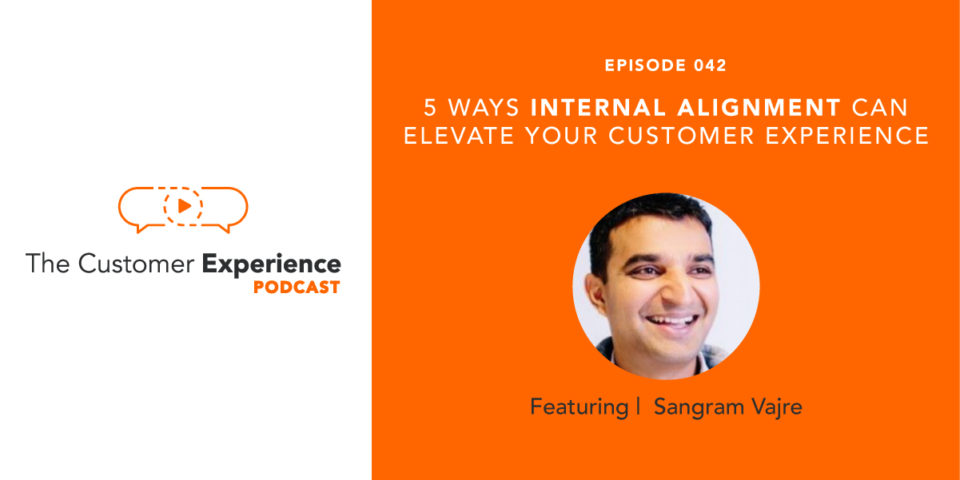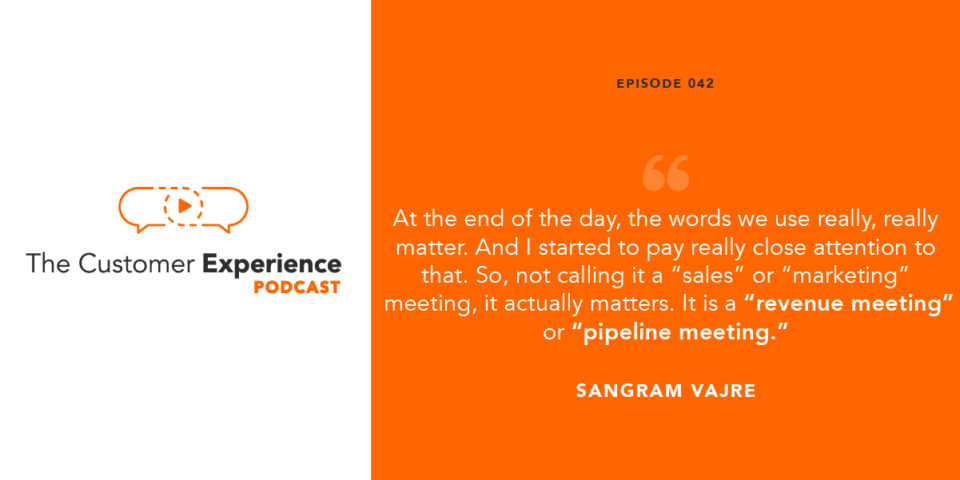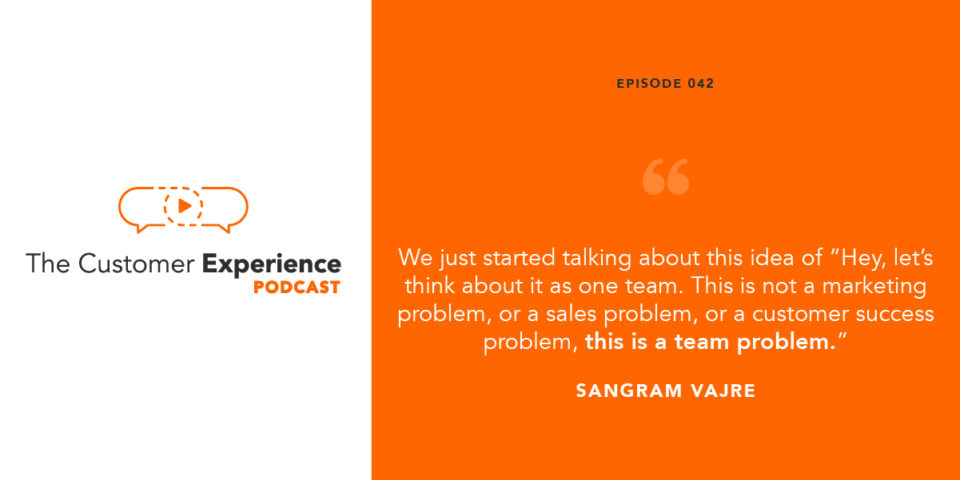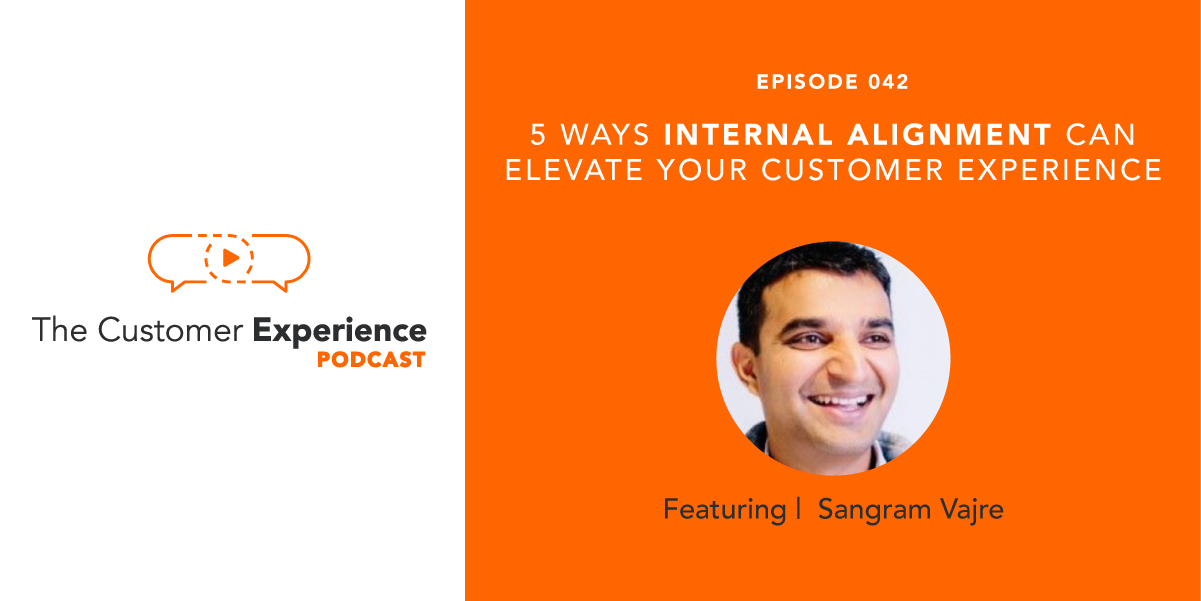
Apple Podcasts | Google Podcasts | Stitcher | Spotify
In most companies, creating and running separate departments to plan and execute different functions, roles, and tasks makes sense. But how can you bring your team members together in the right ways and the right moments in service of your customers?
Historically, the departments look something like this: marketing generates opportunities for sales, sales works to turn opportunities into revenue, and customer success works to retain and grow that revenue. Some close variation of this has been the basic model and organizing principle for years. But it can come at a cost … and often everyone suffers, including your customers.
When your customers and future customers interact with your brand, they’re not interacting just with a single person or even a department. The customer assigns her or his experience to your company as a whole.
So, how do we improve internal alignment throughout our teams to elevate our customer experience? How do we operate as one team instead of separate, siloed departments?
Today’s guest wrote the book on how to organize and task your teams with more clarity about, focus on, and alignment toward your best-fit customers. He speaks to the primary theme of this podcast and he’s an exceptional human being, so I couldn’t be more pleased to host Sangram Vajre, cofounder and Chief Evangelist at Terminus (which he calls “accidental”), coauthor of ABM is B2B (which I highly recommend), and host of the #FlipMyFunnel Podcast (which is daily!).
How does he think about customer experience? To Sangram, it’s whatever your customers say about you, not what you say about yourself. Your customer’s reality is the reality.
In this short clip, we talk about the feelings and stories that result from CX …
In Sangram’s view, customer experience is best delivered by “one team” – your separate departments working with an internal alignment toward your customer. And the results speak for themselves. With a 4,730% growth rate over the past three years, Terminus recently landed at #61 overall and #8 among software companies on the Inc. 5000 list of the fastest-growing, privately-held companies in the US.
During our conversation, he shares five ways to better align your people to deliver a better customer experience:
1: Schedule Better Meetings
2: Set Meaningful, Holistic KPIs
3: Foster Cross Department Relationships
4: Celebrate Company Wins as One Team
5: Adopt Account-Based Marketing
It’s worth noting that this is a very free-flowing conversation. These themes are only a small part of the valuable recommedations, insights, and expertise that he brings to this episode.
Enjoy!
5 Ways Internal Alignment Can Elevate Your Customer Experience
The Customer Experience Podcast is available in your preferred podcast player.
Listen and subscribe in Apple Podcasts, Spotify, Google Podcasts, or Stitcher.
The recording of each conversation can also be heard right here. We embed each one in its companion blog post at BombBomb.com/Podcast.
Listen and learn with the “Accidental Evangelist” Sangram Vajre right here …
1: Internal Alignment Through More Focused Meetings
The days of standing, recurring, and general “sales” or “marketing” meetings are over. We need to give up and let go. We can’t afford meetings that cost too much time, deliver too little value, and fail to create alignment.
Check out the next clip to see why Sangram cleared his calendar of all standing meetings and how he approaches them now …
In short:
- No indefinitely recurring meetings
- Project-based meetings that last four or six weeks only
- Short, 25-minute meetings
- Clear meeting owners who drive focus, intention, and action
Instead of a weekly “marketing” meeting, schedule a “revenue meeting” or a “pipeline meeting” with all the right people in the room. This provides more focus and breaks down silos.
Words matter. The name matters. The purpose matters. Make your meetings matter.
Note: for more tips on better meetings, here’s a short, fun presentation I delivered at BombBomb.

2: Align Around Better Metrics and Customer Outcomes
Creating change means starting at the top with a guiding philosophy and works its way down to practical execution. How your team members are measured directly affects the way they think about and execute their work. It also affects the company as a whole.
In the next clip, Sangram tells one of my favorite stories and lessons from his time running marketing at Pardot and Salesforce. It includes a guiding philosophy that left him feeling like he and his team were just a “coin-operated lead machine,” rather than a team helping create pipeline velocity, supporting cross-selling and upselling (or “upserving”), and truly driving revenue in an aligned way.
What he shares here is part of the reason he cofounded Terminus …
Terminus stopped obsessing over lead generation and instead got intensely focused on pipeline velocity, conversion points, and revenue generation. Why? Because it broadens the focus of marketers and aligns them with the sales and customer success teams. It’s a more holistic perspective. It keeps the customer journey in full view. Also … revenue!
The same way your chosen metrics and KPIs affect the customer experience, other obsessions can, too. Think, for example, about how your team rallies around feature releases. Do you treat them like “silver bullets” that will solve all of the company’s and customers’ problems?
Sangram shares a story about a healthier approach in this video clip …
We’ll never have a complete, finished, or perfect product. So every time a new feature comes out, don’t prioritize it or obsess over it beyond the basics: the problems and opportunities your customers face.
So, his recommendation is to collectively obsess as one team over how you can help your customers and future customers. Hone in on that every day. Features matter, but don’t lead with them.
Note: if you like the idea of focusing on the problem rather than the product, you might like this #FlipMyFunnel podcast series about tech evangelism.
3: Encourage Interaction Between Teams
Take a look around your office. I’m guessing that like many others, your sales team is seated separately from your marketing department. They might even be on separate floors. I’d even wager that this never seemed especially strange or improper. But Sangram strongly encourages you to stop accepting this as the standard.
Watch this next clip to see another take on KPI alignment and an argument in favor of rearranging your team members for physical alignment …
A pod-based, outcome-based arrangement further supports the internal alignment that better meetings and better metrics create.
Once you align the KPIs of every department and team member toward the company goals, people will naturally shift toward working together. But to foster these connections and relationships, you need to bring people together physically.
If your company is more decentralized or has many people working remotely, Sangram recommends video as the solution (an idea I’m inclined to agree with). Using video helps team members get face to face with each other, which plain, typed-out messages just can’t do.
A recurring theme throughout our conversation is that our customers see us as one team and, therefore, we should see ourselves the same way. We should organize, plan, and act as one team with shared ownership and accountability.
In this next clip, Sangram shares more on the #OneTeam philosophy by which Terminus operates …
#OneTeam shares its problems and its opportunities. You don’t have a marketing problem, a sales problem, or a CS problem. Your team has a shared problem. We have to own the experience (for more on this, Sangram recommends Extreme Ownership).
You don’t have a “sales and marketing meeting.” You have a “go to market meeting.”
Hopefully, you’re starting to see how these strategies for internal alignment layer in with one another.

4: Celebrate The Wins As #OneTeam
If you’re going to own problems and opportunities together, then you should celebrate the results together.
With very little effort, you can start celebrating the company wins with the whole company today. As you find ways to do this, each person sees their efforts and outcomes rolling up into collective success more clearly.
Draw out the links explicitly. Make it clear how internal alignment across teams drove the shared win.
This creates an environment in which each team member feels a sense of responsibility toward, ownership of, and accountability for the company’s future.
5: Implement Account-Based Marketing
Before we dive into how to get started with Account-Based Marketing (ABM) strategies, we’ll hear from the “Accidental Evangelist” who’s helping define the category and lead the movement.
Watch the next clip to see how Sangram, author of Account-Based Marketing for Dummies and coauthor of ABM is B2B, shares the basics of the ABM mindset and approach …
As an ABM industry leader, Sangram provides a deep and wide range of knowledge on the topic. This evolutionary approach to marketing focuses your team’s marketing efforts toward very specifically targeted accounts. It’s a shift toward precision and away from volume.
Once you understand the basics of ABM, you can start implementing tactics with your “one team.” Check out the next clip to learn the best way to start the adoption within your organization, even if you’re still stuck on the leads treadmill …
Define an experiment. Generate ideas for execution. Try out the ideas. Measure the results, which should speak for themselves. Then share the outcome with others.
Remember, this isn’t a “marketing initiative.” It’s a team initiative, even when you start with a small experiment.
Sangram does provide a word of caution not to get stuck on one mindset for how this can be done. ABM, like any business approach or philosophy, should be adapted for use within your company – and it will evolve from there.
See how it’s evolved in Sangram’s view and hear a great success story in this video clip …
As Account-Based Marketing grows, Sangram continues to meet fellow practitioners who are realizing that ABM is so much more than a marketing strategy. It’s how B2B marketing and sales should done.
The ABM approach respects your customers and future customers, improves results, and requires internal alignment.
BONUS How Zappos Creates Internal Alignment
Zappos, a brand for its exceptional customer experience, has been mentioned before here on The Customer Experience Podcast. Sangram mentions them again – and smartly.
He recently read Tony Hsieh’s classic book Delivering Happiness. After 20 years in business, including a $1.2B acquisition by Amazon a decade ago, the CEO attributes the success of his company to Brand, Culture, and Pipeline (or BCP).
Pipeline, by the way, captures employee education, development, and engagement.
Sangram explains it all in this final video clip …
Hseih doesn’t mention product or lead generation. He doesn’t talk about the shoes and apparel you can buy through his company. He only talks about developing a community of employees and customers. If you empower people to constantly learn and grow, you empower them to do the same with your customers.
That’s how you elevate the narrative. And that’s how you create an extraordinary customer experience.
As Sangram always says: Without a community, you’re a commodity! Community is the one thing no competitor can copy or take away.
Note: if you like the idea of employee and customer engagement and the BCP framework, you might like this podcast episode about The Service Profit Chain.
This post is based on a conversation with Sangram Vajre, the Chief Evangelist at Terminus, coauthor of ABM is B2B, and host of the #FlipMyFunnel Podcast.
For more expert insights from marketing, sales, and customer success professionals, subscribe to The Customer Experience Podcast!
If you’ve got a minute, please leave a rating or review – it’s very helpful to the podcast’s success.
What You Get From The Customer Experience Podcast
Dozens of Available Episodes Including …
- “No, Your Customer Isn’t Always Right” with Jaime Casap (Chief Education Evangelist, Google)
- “Why Customer Experience Is The Only Differentiator Left” with David Cancel (CEO and founder, Drift)
- “The Financial Side of CX: Which Customers Should You Invest In?” with Sarah Toms (Cofounder and Director, Wharton Interactive)
- “You Have 100 Days To Create Or Lose A Customer For Life” with Joey Coleman (Never Lose A Customer Again)
Great Guests Ahead Including …
- Scott Barker – Sales Enablement Evangelist at Outreach and Head of Partnerships at Sales Hacker
- Wes Bush – Founder of The Product-Led Institude and author of Product-Led Growth
- Kristin Messerli – founder and CEO at Cultural Outreach
Elevate Your Communication to Elevate Your Employee Experience and Customer Experience
Every day, you entrust your most important and most valuable messages to a form of communication that doesn’t build trust, doesn’t differentiate you, and doesn’t communicate nearly as well as if you just looked people in the eye and spoke to them.
There’s a better way! Simple, personal videos allow you to be truly seen, heard, and understood. More importantly, they let the people who matter most to you and your business know that they’ve been seen, heard, and understood by you.






